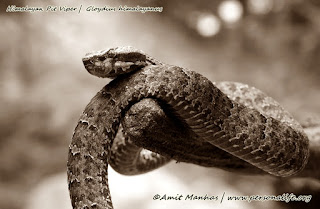Gloydius himalayanus is commonly known as Himalayan pit viper or Western Himalayan Pitviper belonging to family Viperidae of a venomous s...
Gloydius himalayanus is commonly known as Himalayan pit viper or Western Himalayan Pitviper belonging to family Viperidae of a venomous species of pit vipers. It is dispersed and endemic to the Himalayan territory of three nation viz., India (northern), Nepal and Pakistan (northeastern zone). Gloydius himalayanus is the only species under the genus Gloydius, as no subspecies have been documented so far. Besides, it the only pit viper species that has been found in some localities and nations such as in Pakistan and in Kashmir division and high ranges of Jammu division viz., Doda, Bhaderwah, Kishtwar, and Ramban.
Himalayan pit viper is a mountainous snake who
prefer to stay at rocky wooden hill sides nearby water resources, where it live,
hide and hibernates in winters (October to April) in potholes and rock crevices
depending on the weather conditions of the region. As a highland snake, it has
sighted at an altitudinal range of 1500- 4900 m.asl. The species can be sighted
basking in bright sunny days in winters. It is a nocturnal and territorial species
which generally is very lethargic by nature, try to flee at first on sighting
but can attack fiercely on provoking repeatedly. In its territorial range it prefers
to take refuge beneath collapsed wood, rock crevices, under boulders, underneath
rocks, racks and fallen leaves.
Scientific
classification
|
|
Kingdom:
|
Animalia
|
Phylum:
|
Chordata
|
Class:
|
Reptilia
|
Order:
|
Squamata
|
Suborder:
|
Serpentes
|
Family:
|
Viperidae
|
Genus:
|
Gloydius
|
Species:
|
himalayanus
|
Binomial
name
|
|
Gloydius
himalayanus, Günther (1864)
|
|
It is medium-sized serpent having clearly distinct &
elongated head covered under large proportioned scale shields; along with a
distinct heat sensing pit between the eye and nostril on both sides. Eyes are of
medium size having vertical pupil. The dorsal side of body is somewhat brownish,
gray to dark brown stippled to form an arrangement of transverse bars. Besides,
a band of dark black color passes from eye to angle of mouth. The dorsal
scales are extremely keeled. On the ventral sides, scales are grayish with whiten outline or
whitish with grayish outline having black dots laterally. Tail is very short in
these snakes as compared to rest of the body.


Gloydius himalayanus
The scalation observed is: Supra-labial scales 7/7 (light colored having
dark mottling) ; infra-labials 9-11/9-11; Supraocular Scales 2; Parietal Scales
2; Prefrontal Scales 2; temporal Scales 2+3; Frontal Scales 1; Dorsal Scales (A-Anterior;
M-Midbody; P-Posterior) 21 (A): 23 (M):17 (P); Anal plate undivided; Ventral
Scales 147-175 & subcaudal Scales 32-52.
Gloydius himalayanus can attain maximum length of 3.5 ft. overall an
average length of the species range between 2.5 ft. to 3 ft. Below is the average size variation of the serpents
observed from Doda region of Jammu & Kashmir, India by Manhas et. al.,
(2018).
Full body length
|
570
mm-658 mm
|
Snout-vent
length
|
480 mm-558
mm
|
Tail length
|
90 mm-100
mm
|
Himalayan Pit Viper fall
among the viviparous species of snakes which gives birth to live young’s
directly and in its range it prefers to feed on birds, rodents, insects and small
reptiles also. This species of snake is mildly venomous and is non-fatal, a
bite of this serpent results intense local pain, swelling, blistering, necrosis
plus coagulopathy, bleeding and may lead to renal failure. However in some
reports it is documented as a non-fatal venomous species whose bite symptoms subsides
after some days without treatment. Excessive clinical study needed to be initiated
to gather more detailed information on its envenomation symptoms and results.
There is no potential threat
to the species in its range except the unwarranted killings out of fear and
loss of habitat which needs to be sorted out by awaring the local masses.
Literature cited:
Agarwal, I., Mistry, V.K. and Atreya, R. 2010. A preliminary checklist of reptiles of Eaglenest Wildlife Sanctuary, West Kameng district, Arunachal Pradesh, India. Russian Journal of Herpetology, 17 (2): 81-83.
Boulenger, G.A. 1890. The Fauna of British India, Including Ceylon and Burma. Reptilia and Batrachia. Taylor & Francis, London - get paper here
Boulenger, G.A. 1896. Catalogue of the snakes in the British Museum, Vol. 3. London, Taylor & Francis - get paper here
Chaudhuri, A., Mukherjee, S., Chowdhury, S. and Purkayastha, J. 2018. Geographic Distribution: Gloydius himalayanus (Himalayan Pitviper). Herpetological Review, 49 (3): 505 - get paper here
Chowdhary, N. 2010. Diversity and status of Wildlife fauna of district Rajouri (J&K state), PhD thesis submitted to Jammu University (Unpublished).
Daniel, J.C. 1983. “The Book of Indian Reptiles”, Bombay Natural History Society, Oxford University press, Mumbai, India.
Daniel, J.C. 2002. “The Book of Indian Reptiles and Amphibians”, Bombay Natural History Society, Oxford University press, Mumbai, India.
Das, S.M. (1966). Palearctic elements in the fauna of Kashmir. Nature, 212 (5068): 1320-1330.
Das, S.M., Malhotra Y.R. and Duda, P.L. 1964. The Palaearctic elements in the fauna of Kashmir region. Kashmir Science, 1 (1–2): 100–111.
Duda, P.L. and Sahi, D.N. (1977). An uptodate checklist of herptiles of Jammu & Kashmir. Jammu and Kashmir University Review, 6 (10): 1-7.
Gloydius himalayanus at Wikipedia Retrieved 01 May 2020
Gloydius himalayanus at the Reptarium.cz Reptile Database Accessed 01 May 2020
Gloydius himalayanus at Wildlife of Pakistan, Accessed 01 May 2020
Günther, A. 1864. “The Reptiles of British India”, Taylor & Francis, London - get paper here
Himalayan Pit Viper at Toxinology.com Retrieved 01 May 2020.
Jamal, Q., Idrees, M., Saif, U., Adnan, M., Zaidi, F., Qaiser, Z. and Rasheed, S.B. 2018. Diversity and Altitudinal Distribution of Squamata in Two Distinct Ecological Zones of Dir, A Himalayan Sub-Zone of Northern Pakistan. Pakistan J. Zool., 50 (5): 1835-1839 - get paper here
Kästle, W., Rai, K. and Schleich, H.H. 2013. FIELD GUIDE to Amphibians and Reptiles of Nepal. ARCO-Nepal e.V., pp. 625- get paper here
Khaire, N.K. 2010. “Snakes”, In: Milind, L.P. (Eds.). Jyotsna Prakashan Dhavalgiri, Pune, India
Khaire, N.K. 2015. “Indian Snakes a field guide”, In: Milind, L.P. (Eds.). Jyotsna Prakashan Dhavalgiri, Pune, India
Khan, M.S. 1983. Venomous terrestrial snakes of Pakistan. The Snake, 15 (2): 101-105.
Khan, Q.A. and Khan, S.M. 1996. Snakes of state of Azad Jammu and Kashmir. Proceedings of. Pakistan Congress of Zoology, 16: 173-182.
Manhas, A. 2017. Role of varying climatic regimes on the Reptilian fauna under temperate and tropical conditions, PhD thesis submitted to Barkatullah University (Unpublished).
Manhas, A., Raina, R. and Wanganeo. A. 2016. An assessment of reptilian diversity and their distribution in Jammu and Kashmir state from Jammu City in northern India: A case study. International Journal of Fauna and Biological Studies, 3(3): 20–23.
Manhas, A., Raina, R. and Wanganeo. A. 2018. Reptilian Diversity and Distributions in the Doda District of Jammu and Kashmir, India. IRCF Reptiles and Amphibians, 25 (3): 164–169.
Murthy, T.S.N. and Sharma, B.D. 1976. A contribution to the Herpetology of Jammu and Kashmir. British Journal of Herpetology, 5: 533-538.
Murthy, T.S.N. and Sharma, B.D. 1979. Second report on the herpetofauna of Jammu and Kashmir. The snake, 11: 234-241.
Nanhoe, L.M.R. and Ouboter, P.E. 1987. The distribution of reptiles and amphibians in the Annapurna-Dhaulagiri region (Nepal). Zoologische Verhandelingen, (240): 1-105 - get paper here
Sahi, D.N. 1979. A contribution to the herpetology of Jammu and Kashmir, Ph.D. Thesis submitted to University of Jammu (Unpublished).
Sahi, D.N. and Duda, P.L. 1985. A checklist and keys to the amphibians and reptiles of Jammu and Kashmir State, India. Bulletin of Chicago Herpetological Society, 20 (3-4): 86-97.
Sahi, D.N. and Duda, P.L. 1986. Affinities and distribution of amphibians and reptiles of Jammu and Kashmir state (India). Bulletin of Chicago Herpetological Society, 21(3-4): 84-88.
Saikia, U., Sharma, D.K. and Sharma, R.M. 2007. Checklist of the Reptilian fauna of Himachal Pradesh, India. Reptile Rap (8): 6-9 - get paper here
Smith, M.A. 1943. The Fauna of British India, Ceylon and Burma, Including the whole of the Indo-Chinese sub-region. Reptilia and Amphibia. 3 (Serpentes). Taylor and Francis, London.
Swan, L.W. and Leviton, A.E. 1962. The herpetology of Nepal: a history, check list, and zoogeographical analysis of the herpetofauna. Proc. Cal. Acad. Sci., 32 (6) (4.s.): 103-147. - get paper here
Wall, F. 1906. “The poisonous snakes of India and how to recognize them”, Part II, J. Bombay Nat. Hist. Soc., 17: 299-334 - get paper here
Whitaker R. and Captain A. 2004. “Snakes of India”, the Field Guide. Draco Books, Chennai, Tamil Nadu, India reprinted 2007 - get paper here
Whitaker, R. 2006. “Common Indian snakes” a field guide. Macmillan India press, Chennai, (Tamil Nadu), India.
Watch Below














COMMENTS